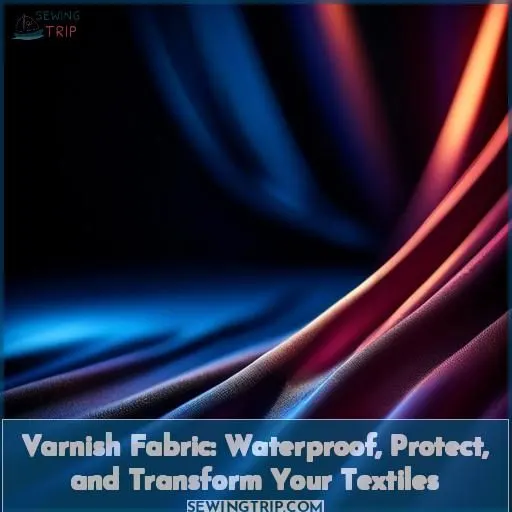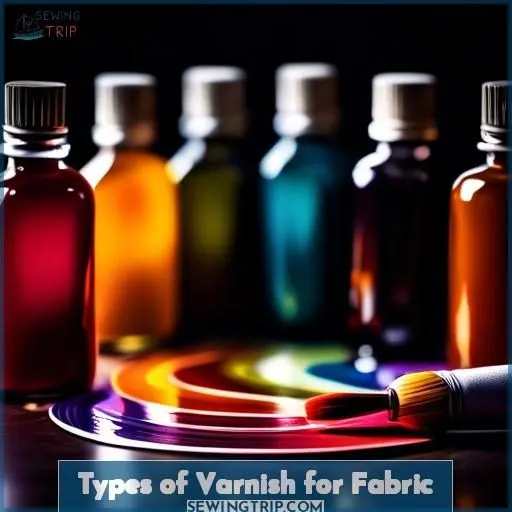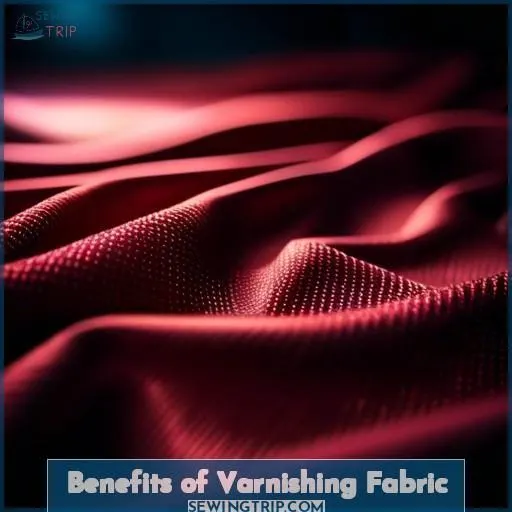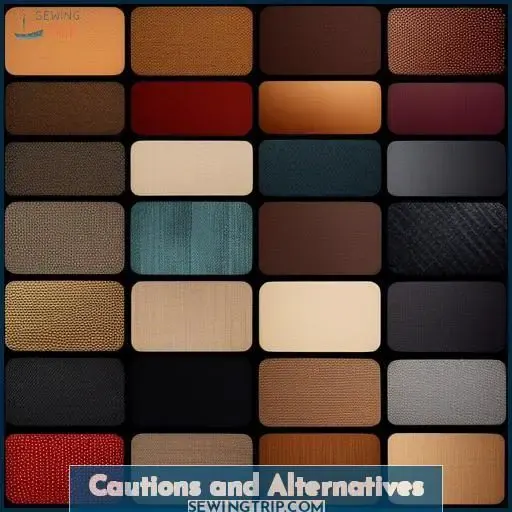This site is supported by our readers. We may earn a commission, at no cost to you, if you purchase through links.
Yes, you can absolutely varnish fabric to create durable, water-resistant textiles. It transforms ordinary fabrics into surfaces that defy the elements.
Choose from oil-based, water-based, polyester resin, or epoxy varnishes—each with unique properties.
Apply via dipping, draping over frameworks, or using wire/staples.
Varnishing waterproofs, prevents fading/bleaching, guards against degradation, and adheres fabric to frames.
Proceed cautiously with epoxy; polyester resin offers a safer alternative.
Take precautions against excessive sun exposure.
Explore varnishing to reveal fabric’s untapped potential.
Table Of Contents
Key Takeaways
- Varnishing fabric can transform ordinary textiles into durable, water-resistant materials that can withstand the elements.
- There are several types of varnish available, including oil-based, water-based, polyester resin, and epoxy, each with unique properties and application techniques.
- To apply varnish to fabric, you can use dipping, draping over frameworks, or using wire or staples to secure the fabric in place.
- Precautions must be taken when using epoxy and polyester resin, as they require careful handling and may not provide an adequate bond. Additionally, fabric must be protected from excessive sun exposure to prevent fading, bleaching, and fiber degradation.
Can You Varnish Fabric?
Yes, you can varnish fabric. Varnish can be used to waterproof and protect textiles, as well as give them a glossy finish. However, the type of varnish used and the application method can vary depending on the specific fabric and desired outcome.
For example, water-based decoupage varnish and glue can be used for textiles and fabrics, while acrylic varnishes or faux finish medium can stiffen and provide a glossy finish.
It’s crucial to follow the manufacturer’s instructions and test the varnish on a small, inconspicuous area before applying it to the fabric.
Types of Varnish for Fabric
In the realm of fabric varnishing, diverse options await: oil-based varnish, water-based varnish, polyester resin, and epoxy. Each alternative boasts distinct traits and considerations, making it imperative to dissect their disparities to ascertain the ideal match for your endeavor.
Oil-based Varnish
Delve into the realm of oil-based varnish to bestow a sturdy protection upon your fabric creations. Its extended drying window affords ample opportunity to finesse your brushwork to perfection.
Preparation is paramount—commence with a pristine surface prior to varnishing your fabric. Should the need arise to rectify any missteps, oil-based varnish removal serves as your safeguard.
Water-based Varnish
Water-based varnish is a versatile material that can be applied to fabric to provide a range of benefits. When using water-based varnish, it’s essential to follow the correct application techniques to guarantee the best results. Here’s a step-by-step guide on how to apply water-based varnish to fabric:
- Brush application: Dip a clean brush into the water-based varnish and apply it evenly to the fabric. Ensure that the brush isn’t overloaded with varnish to avoid drips or runs.
- Fabric preparation: Before applying the varnish, prepare the fabric by cleaning it thoroughly and allowing it to dry completely. This step is crucial to guarantee the varnish adheres properly to the fabric.
- Drying time: Water-based varnish dries quickly, so it’s essential to apply the varnish in thin, even coats. Allow each coat to dry completely before applying the next one.
- Varnish durability: Water-based varnish is known for its flexibility and resistance to wear and tear. It’s suitable for a wide range of applications, including textile painting and fabric art.
- Fabric paint: If you plan to paint on the textile, use a compatible fabric paint that’s suitable for water-based varnish. Apply the paint in thin, even coats, allowing each coat to dry before applying the next one.
- Textile painting: Water-based varnish can be used for textile painting, providing a durable and protective layer over the paint. It’s essential to follow the correct painting techniques to guarantee the paint adheres properly to the fabric.
- Protecting fabric art: Once the varnish has dried, apply a thin layer of matte varnish to maintain the color and enhance the durability of the fabric art. This step is crucial to prevent the fabric from fading or degrading over time.
- Cleaning up: Water-based varnish is easy to clean up, as it doesn’t require solvents. Simply clean your brushes and tools with water and soap.
Remember to follow the specific instructions provided by the varnish manufacturer to guarantee the best results. With the right application techniques and materials, water-based varnish can help you create beautiful, durable fabric art that withstands the test of time.
Polyester Resin
Polyester resin is a versatile choice for varnishing fabric. Here are four key points to keep in mind:
- Durability: Polyester resin offers a good balance between strength and flexibility, making it appropriate for a variety of applications.
- Application: Apply polyester resin with a brush or roller, making sure the coverage is even.
- Strength: Polyester resin provides a strong bond between layers of fabric and can be used as an adhesive in certain cases.
- Bonding: When using polyester resin, it’s important to make sure the curing time is correct to achieve the best bonding strength.
Epoxy
Epoxy, a robust and enduring adhesive and sealant, can be employed to varnish fabric. Its notable attributes include exceptional bonding strength and resilience against environmental influences. Nonetheless, its swift-setting properties and the necessity for meticulous mixing present potential obstacles. Adhering to epoxy safety protocols and maintaining proper storage and accessibility are crucial for effective application.
Application Techniques
To apply varnish to fabric, you can dip the cloth directly into the varnish solution, allowing it to soak through the fibers. Alternatively, you can drape the fabric over a rigid framework, then secure it in place using wire or staples before brushing or spraying on the varnish, allowing you to create three-dimensional shapes and forms.
Dipping Fabric in Varnish
To achieve optimal results when dipping fabric in varnish, follow these steps:
- Consistency: Make sure the varnish has the appropriate consistency for your fabric. For oil-based varnish, it should be thin enough to spread uniformly but not overly liquid. For water-based varnish, it should be thick enough to stick to the fabric without leaving streaks.
- Fabric Selection: Select a fabric that’s compatible with the varnish. Some fabrics may absorb the varnish too quickly, while others may not absorb it at all. Test the varnish on a small, inconspicuous area of the fabric before proceeding.
- Drying Time: Allow the varnish to dry completely before handling the fabric. Drying times can vary depending on the type of varnish and the ambient conditions. For oil-based varnish, it may take several hours to dry, while water-based varnish can dry within a few hours.
- Brush Type: Use a clean, soft-bristled brush to apply the varnish. A synthetic brush is recommended for water-based varnish, while a natural-bristle brush is more suitable for oil-based varnish.
- Varnish Thickness: Apply the varnish in thin, even coats. Excessive varnish can cause the fabric to become stiff or tacky, while insufficient varnish may not provide adequate protection.
Draping Fabric on Framework
Stretching fabric over a framework is a technique used to create tension fabric structures, which are commonly found in various industries, including commercial structures, industrial buildings, and even as temporary shelters. This method involves stretching the fabric over the frame to provide structural support and stability. The fabric is tensioned using multiple methods, varying by manufacturer, to create a tight-fitting cover membrane.
When working with fabric, it’s imperative to contemplate the fabric tensioning techniques to verify a proper fit and functionality of the structure. The fabric should be stretched evenly and securely to the framework, which can be achieved by using various methods such as cables, hooks, or zippers. Additionally, the fabric should be able to withstand the tension without tearing or wrinkling, which is why it’s vital to select the appropriate fabric for the specific application.
When applying varnish to fabric, it’s imperative to contemplate the type of varnish used, as oil-based varnish may glue the fabric to the framework, while water-based varnish may not be strong enough to hold the fabric. It’s also important to safeguard the fabric from sun exposure and rain to prevent fading, bleaching, and fiber degradation.
Using Wire or Staples to Secure Fabric
Regarding securing fabric to a framework, several possibilities present themselves. You might employ wire or staples to maintain everything in place. Here’s an array of techniques for your contemplation:
- Framing alternatives: Opt for a robust framework capable of withstanding the weight and strain of your fabric.
- Tensioning approaches: Apply uniform pressure to prevent wrinkles and maintain a pristine appearance.
- Fabric fortification: Use supplementary materials to bolster areas susceptible to damage or wear.
- Heat application: Utilize heat to establish the fabric and guarantee a lasting connection with the framework.
These methodologies will safeguard your fabric from environmental elements, ensuring its longevity and vibrant appearance outdoors.
Gluing Layers Together
When bonding fabric layers, it’s crucial to account for the adhesive strength, fabric thickness, drying time, and heat resistance. The choice of glue depends on the particular needs of the project. For example, Aleene’s Super Fabric Adhesive is an industrial-strength glue that dries quickly and remains ultra-flexible, making it suitable for heavy fabrics like denim, leather, and canvas. On the other hand, Aleene’s Quick Dry Fabric Fusion is a super strong fabric glue that dries up to 5 times faster than the original formula and adheres to all kinds of fabrics and embellishments for a permanent bond that remains flexible even after washing.
To bond layers together, follow these steps:
- Prepare the fabric by ensuring it’s clean and dry.
- Apply the adhesive evenly to the edges of the fabric layers using a clean brush or applicator.
- Press the layers together firmly, making sure they’re aligned properly.
- Apply additional adhesive if necessary to secure the layers.
- Allow the glue to dry according to the manufacturer’s instructions, typically for 2-3 minutes for quick-drying glues or up to 24 hours for permanent adhesives.
- Once the glue has set, the fabric layers will be securely bonded together.
When working with different types of fabric, it’s essential to choose the appropriate glue to ensure a strong bond. For example, Tear Mender Instant Fabric Adhesive is suitable for thicker fabrics like denim, leather, or canvas, while Fabric Fuse Fabric Glue is ideal for attaching silk embellishments or adornments. Additionally, some glues are designed to withstand high temperatures, making them suitable for fabric projects that will be exposed to heat or hot conditions.
Benefits of Varnishing Fabric
Varnishing fabric offers several key benefits that make it an attractive option for enhancing and protecting textiles. By applying a suitable varnish, you can waterproof the fabric, prevent sun fading and bleaching, mitigate fiber degradation, and effectively glue the fabric onto a desired framework or structure.
Waterproofing
Waterproofing your fabric is an essential step in protecting it from weather damage. Varnish application techniques, such as dipping fabric in oil-based or water-based varnish, can provide water resistance. Epoxy and polyester resin can also be used, but require more skill. Waterproof textiles are ideal for outdoor fabric preservation, ensuring moisture-resistant fabrics.
Preventing Sun Fading
Safeguarding your fabric from sun fading is paramount to maintain its hue and avert premature deterioration. Coating your fabric with a UV-resistant sealant can provide an extra layer of shielding against the sun’s damaging rays. Here are some guidelines on how to prevent sun fading when applying sealant to fabric:
- Select the appropriate sealant: Choose a sealant specifically formulated for UV protection, such as those containing UV-absorbing pigments or additives. These sealants can help block UV rays and prevent color fading.
- Apply multiple layers: Apply at least two to three thin coats of sealant, allowing each layer to dry thoroughly before applying the next. This will guarantee a more uniform and effective UV protection.
- Avoid direct sunlight: If possible, avoid exposing your sealed fabric to direct sunlight immediately after application. Allow the sealant to fully cure before using the item in sunlight.
- Consider alternative methods: If you’re concerned about the effectiveness of sealant in preventing sun fading, consider using alternative materials or methods that offer better UV protection, such as tightly woven or dyed fabrics, or fabrics treated with UV-resistant coatings.
Preventing Bleaching
Bleaching is a prevalent issue in the realm of fabric care and textile conservation. Sunlight and other external influences can deteriorate fabric, causing it to discolor and weaken over time. Here are three ways varnish can aid in preventing bleaching:
- Protective Coating: Varnish forms a protective coating on the fabric, shielding it from the sun’s rays and other environmental factors that can induce bleaching.
- Color Preservation: By encapsulating the fabric, varnish helps to preserve the vibrancy of the colors and prevent their fading.
- UV Defense: Certain varnishes contain UV inhibitors that further enhance protection against bleaching.
To achieve optimal results, opt for a water-based varnish, as it’s less prone to yellowing over time and provides superior color retention. Furthermore, applying multiple thin layers of varnish contributes to building a robust protective coating. Adhere to the manufacturer’s guidelines for best practices.
Preventing Fiber Degradation
Varnishing your fabric can prevent fiber degradation by establishing a protective barrier against environmental conditions.
Different fiber types possess varying absorption rates and chemical interactions.
Thus, it’s essential to evaluate toxicity hazards and application environments when selecting a varnish.
Include a table to contrast the characteristics of oil-based varnish, water-based varnish, epoxy, and polyester resin to assist in making a well-informed choice.
| Product | Pros | Cons |
|---|---|---|
| Oil-based | Durable, water-resistant, flexible when cured | Slow drying, strong odor, requires solvents for cleanup |
| Water-based | Low odor, easy cleanup, environmentally friendly | Less durable, not as water-resistant |
| Epoxy | Strong, durable, resistant to chemicals and abrasion | Complicated application, potential health hazards |
| Polyester | Good adhesion, impact resistance, easy application | Limited chemical resistance, not UV stable |
Gluing Fabric to Framework
To glue fabric to a framework using varnish, you can follow these steps:
- Choose the right varnish for your project. Oil-based varnish is a good option for its strong bonding capabilities, but water-based varnish can be easier to work with. Epoxy and polyester resin are also suitable for this purpose, but they require more care in application.
- Prepare your fabric by cleaning and drying it thoroughly. If the fabric is porous, apply a white undercoat to prevent smudging and enhance color.
- Apply the varnish evenly to both the fabric and the framework. You may need to thin the varnish with a solvent or use a brush to make sure even coverage.
- Allow the varnish to dry completely before handling the fabric. This can take several hours to a few days, depending on the type of varnish and environmental conditions.
- Once the varnish is dry, the fabric should be securely attached to the framework. If the bond isn’t strong enough, you may need to apply additional layers of varnish or use a different adhesive, such as PVA glue or decoupage paste.
- To protect your varnished fabric from sun and rain, consider applying a clear coat, such as acrylic or urethane, to create a barrier against the elements.
Remember to work in a well-ventilated area and follow safety precautions when handling varnish and solvents. With patience and care, you can successfully glue fabric to a framework using varnish, creating a durable and attractive finished product.
Cautions and Alternatives
While varnishing can augment the qualities of fabric, there are some caveats to bear in mind.
Epoxy can be arduous to handle.
Polyester resin may not provide an adequate bond.
Furthermore, varnish may lack the robustness to suitably secure fabric in place.
Exposure to sunlight could still potentially impair the treated material over time.
Consequently, it’s prudent to contemplate alternative materials, waterproofing techniques, adhesives, frameworks, and sculpture designs that may more suitably align with your specific requirements.
Difficulty Working With Epoxy
Epoxy can be a demanding material to work with when varnishing fabric. It necessitates cautious handling and can present health risks, hence safety precautions are critical. If you’re not at ease with epoxy, contemplate alternatives like polyester resin or PVA glue. To safeguard your fabric from epoxy damage, guarantee adequate ventilation, don protective gear, and adhere to the manufacturer’s instructions.
Lower Bonding Strength of Polyester Resin
When you’re eyeing polyester resin for your fabric endeavor, recall it’s the midpoint in the realm of resins.
Its malleability and resistance to the elements are admirable, but it’s not the behemoth of adhesives.
While it won’t deplete your coffers, don’t anticipate it to surpass your artistic aspirations.
It’s sturdy, indeed, but it won’t prevail in a contest of strength against epoxy.
Varnish May Not Be Strong Enough to Hold Fabric
If you’re worried that varnish may not be powerful enough to sustain your fabric, there are substitutes to consider.
You can explore adhesive alternatives like PVA glue or decoupage paste for enhanced bonding strength.
Moreover, reinforcement options such as staples or wire can assist in securing the fabric.
For water-based alternatives, consider using acrylic or urethane clear coats for added durability.
The key is to find the ideal balance between strength and flexibility for your fabric project.
Sun Exposure May Still Damage Fabric
Even with a premium varnish, the sun’s relentless rays can still wreak havoc on your fabric’s longevity. To combat this, consider fading mitigation as your defense. Weatherproofing techniques and sun damage prevention are your tools, ensuring your fabric preservation efforts aren’t wasted. A durable coating is your best friend, keeping those textiles vibrant and resistant against the sun’s daily attacks.
Alternative Materials, Waterproofing Methods, Adhesives, Frameworks, and Sculpture Designs
When considering alternative materials for fabric sculptures, you might explore non-traditional fabrics like leather or canvas.
For waterproofing methods, you could try waxing or using a silicone spray.
If you’re looking for an alternative adhesive, consider using a hot glue gun or a strong double-sided tape.
For frameworks, consider using PVC pipes or metal rods.
Finally, for sculpture designs, think about incorporating found objects or creating custom designs that cater to your specific needs.
Tools and Materials for Varnishing Fabric
You’ll need proper protective clothing, a rigid support structure, stencils, a hair dryer, a stiff card, transfer film, flexible fabric paint, white undercoat, matte varnish, and a clean brush to varnish fabric successfully. Preparation is key – make sure you have all necessary tools and materials ready before starting the varnishing process.
Protective Clothing
As you venture into the transformative realm of fabric varnishing, prioritize protective apparel.
Wear garments that safeguard your hands and eyes from potential splashes and spills.
Work in a space where air circulates freely.
Your chosen gear should repel skin irritations, allowing you to concentrate on honing your skills without unwanted interruptions.
Rigid Support
Regarding safeguarding your fabric artistry, the correct foundation is indispensable. Rigid supports are an exceptional option for preserving the structural integrity of your work and preventing deformation or cracking. These materials can be crafted from wood, metal, or contemporary composite materials, each with its own advantages and disadvantages.
One technique for bonding a fabric support over the face of a rigid panel is to utilize a pH-neutral PVA adhesive or specific acrylic polymers. This creates a less brittle interlayer that can mitigate the transmission of cracks to the ground and paint layers if the rigid support exhibits warping or cracking.
Upon selecting a rigid support, contemplate factors such as the size, ground, and paint layers you’ll be employing. Thicker wooden panels are typically more resistant to structural deformation, while avoiding semi-hardwoods and soft woods like poplar and pine can help prevent the transfer of splits and cracks from the support to the ground and paint layers.
Recall to apply an even layer of pH-neutral PVA adhesive or acrylic gel medium to the surface of the panel prior to adhering your canvas. This guarantees better adherence and eliminates air bubbles.
Stencils
Stencils are a primary instrument for fabric preparation and paint application in various artistic projects. They can support you in creating intricate designs and patterns on your fabric without the need for drawing or painting skills. Here are some tips on how to use stencils effectively:
- Preparation: Begin by ironing your fabric to remove wrinkles and secure a smooth surface for stenciling. Place the fabric on a flat surface, such as a table or plywood, to prevent paint seeping through the fabric. Be certain to remove any ridges or bumps from the surface, as these can transfer and become visible when you stencil.
- Stencil Application: Apply spray adhesive to the reverse of your stencil to secure it in place. Wait for the adhesive to dry before positioning the stencil on your fabric. If you’re using a different brand of stencil, you may need to use low-tack spray adhesive to hold the stencil in place.
- Painting: Use a stencil brush or foam roller to apply paint evenly through the stencil. Avoid overloading your brush with too much paint, as this can cause bleeding. Work swiftly to cover your stencil with paint within 5 minutes, as the medium may dry in the mesh and ruin the stencil.
- Removal: Carefully remove the stencil once the paint has dried, following the manufacturer’s instructions for curing the paint. If you’re using a repositionable adhesive spray, you may be able to reuse the stencil multiple times.
- Considerations: Be aware of the type of fabric you’re stenciling, as some materials may be more difficult to work with than others. Natural fibers like cotton, silk, and linen generally accept paint better than synthetics. Sheer fabrics and velvets can be more challenging to stencil, but it’s still possible.
Hair Dryer
When employing a hair dryer for fabric varnishing, it’s crucial to consider the heat setting, drying time, uniform application, and fabric texture.
A hair dryer should always be utilized on the lowest setting that proves effective for your purpose.
For thicker fabrics or when eliminating excessive moisture from towel-dried fabric, employ a high heat setting. Ensure the dryer is kept moving to prevent overheating sections.
When the fabric is approximately 75-80% dry, transition to a lower heat and speed setting to shape your fabric.
Always employ a cool to warm setting when blow drying fabric to prevent damaging it.
Stiff Card
Stiff card is a versatile tool for fabric art that can be employed in a variety of ways. Here are three ways you can use stiff card to elevate your fabric art projects:
- Cutting fabric: Stiff card can be utilized as a cutting guide for fabric. By positioning the card atop the fabric, you can trace around it to create straight lines or shapes. This is especially beneficial when working with delicate or stretchy fabrics that can be challenging to cut precisely.
- Drying fabric: After painting or applying fabric varnish, it’s crucial to allow the fabric to dry flat to avoid wrinkles and distortion. Stiff card can be employed as a base to lay the fabric on as it dries. This guarantees that the fabric remains flat and doesn’t crease or warp.
- Painting fabric: Stiff card can be utilized as a support for painting fabric. By attaching the fabric to the card with pins or tape, you can create a stable surface for painting. This is particularly useful when working with large or heavy fabrics that might be challenging to handle otherwise.
Transfer Film
Transfer film, also known as DTF (Direct to Film) transfer film, is an essential element in the longevity of custom prints, especially in the context of DTF transfers. This film layer provides an additional layer of defense, guaranteeing that the design remains intact despite repeated washings. The film is constructed from superior materials designed specifically for durability, resisting fading, cracking, and peeling** over time.
In the context of DTF transfers, the film layer fulfills a critical role in maintaining the vibrancy and integrity of the print. It acts as a shield, protecting the design from friction, moisture, and wear and tear. This layer is engineered to endure various environmental conditions, including sunlight exposure, extreme temperatures, and humidity.
To enhance the durability of DTF transfers, adherence to the manufacturer’s care instructions is paramount. Washing DTF printed garments inside out with gentle detergents contributes to the preservation of the design. Additionally, avoiding the use of abrasive materials during washing or drying, opting for gentle drying methods, and storing garments appropriately to prevent wrinkling or creasing are recommended practices.
Flexible Fabric Paint
Embark on a journey into the realm of adaptable fabric paints, where the kaleidoscope of hues surpasses the boundaries of your imagination.
These paints not only ignite with vibrancy but also exhibit unwavering endurance, bonding with your textiles with an unyielding grip.
Their expedient drying time allows them to harmonize with a tapestry of fabrics, ensuring your artistic creation endures the relentless passage of time and the whims of nature.
White Undercoat
When readying fabric for varnishing, employing a white base coat is essential for various reasons. Primarily, it elevates the fabric’s color by providing a neutral foundation for the varnish to adhere to. This is particularly significant when changing from a dark to a light color, as the base coat aids in erasing the underlying color, allowing the varnish to achieve an unmatched depth of color. Secondly, the white base coat prevents smearing, guaranteeing that the varnish adheres evenly to the fabric. Finally, it creates a uniform surface for the varnish to adhere to, enhancing the overall appearance and long-term performance of the varnish.
To apply the white base coat, follow these steps:
- Verify that the fabric is clean and devoid of any dirt or debris.
- Apply the base coat uniformly to both sides of the fabric.
- Allow the base coat to dry completely before proceeding with the varnishing process.
Bear in mind to use a clean brush for varnish application to prevent any smudges or uneven application.
Matte Varnish
Matte varnish is a protective coating that can be applied to fabric to enhance its color and durability.
It provides a matte finish that can help prevent the fabric from fading or becoming discolored over time.
Matte varnish is also suitable for waterproofing garments, as it creates a barrier against water and moisture.
When applying matte varnish to fabric, it’s essential to use a clean brush and apply thin, even coats, allowing each layer to dry completely before applying the next.
It’s recommended to use a matte varnish specifically designed for fabric, as some varnishes may not adhere well to the material or may cause discoloration.
Clean Brush
Clean brushes are critical for applying varnish to fabric.
Brush maintenance and storage are vital to preserve their integrity.
Suggested brushes include synthetic bristle brushes.
Alternatively, you can use foam brushes or a sponge applicator for a more even finish.
Consistently clean your brush after use and store it in a dry, clean location to ensure its readiness for your next project.
Frequently Asked Questions (FAQs)
What is the recommended ratio of mixing varnish with water before application?
You don’t typically mix varnish with water, bud. Varnish is meant to be applied straight from the can or container. Just make sure to follow the manufacturer’s instructions for best results on your fabric project.
Can I use water-based varnish on a fabric that has been previously varnished with a non-removable water-based varnish?
You can absolutely layer water-based varnishes, no problem! Just make sure the initial coat is fully set before applying the new varnish layer. This’ll give you a nice, durable finish that’ll make that fabric pop!
How long should I wait between applying coats of varnish to ensure proper drying and adhesion?
Ah, the age-old varnish conundrum. Listen up, my friend – you’ll want to wait at least 4 hours between coats to let that stuff properly dry. Trust me, rushing it will only lead to a hot mess.
Is it necessary to sand the fabric before varnishing it?
You don’t need to sand the fabric before varnishing – just make sure it’s clean and free of any debris. The varnish will adhere nicely without any additional prep work. Just take your time and apply those coats carefully for a smooth, durable finish.
Can I use a different type of varnish, such as epoxy or polyester resin, instead of oil-based or water-based varnish for fabric?
Friend, heed! The canvas of life is your playground – where epoxy and polyester resin dance, bestowing waterproofing and sheen. Yet, tread carefully, for these elixirs demand deft hands. Harness their power, and your fabric shall sing a symphony of resilience.
Conclusion
Coincidentally, you’ve just uncovered the secret to transforming your ordinary fabrics into waterproof, sun-resistant masterpieces. By carefully selecting the right type of varnish and mastering the application techniques, you can absolutely varnish fabric to realize its full potential.
Whether you’re looking to protect outdoor furnishings or breathe new life into vintage textiles, varnishing offers a versatile solution to shield your fabrics against the elements.
Embrace the power of varnished fabric and delve into the boundless possibilities it offers.












